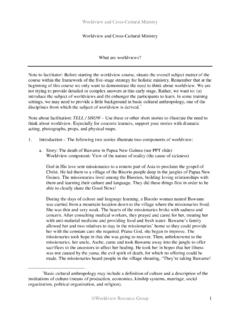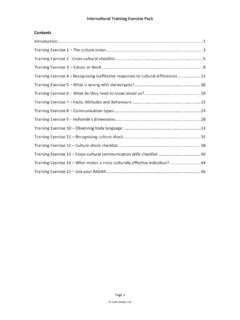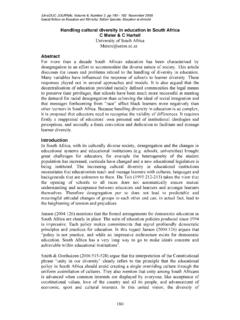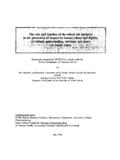Transcription of Social and Cultural Influences on Obesity - …
1 21 Social and Cultural Influences onObesityJeffery SobalCornell University,Ithaca,NewYork,USAINTRODUCTIO NO besity may be defined as the condition of havinghigh levels of stored body fat. Relative body weightis commonly used to describe Obesity , and peoplewho are obese are commonly described as beingoverweight. Obesity and overweight are complexbiopsychosocial phenomena that are shaped bymany factors, including a variety of Social and cul-tural chapter will examine patterns of fatness andthinness using Social science perspectives to frame,review, and discuss Social and Cultural influences onobesity. Framing the influences on Obesity first in-volves examining the larger Social contexts of cul-ture and history, and then considering the morespecific Social characteristics of individuals. Societalmechanisms involved in energy intake and energyexpenditure will be discussed in light of their collec-tive contribution to rising levels of body , conclusions about the Social aspects ofweight will be CONTEXTSTwo major Social contexts provide overarching per-spectives for framing Obesity : culture and culture within which a person lives is likely tobe the most powerful influence on their eating pat-terns, activity levels, and body weight.
2 Within eachculture, conditions change (sometimes dramati-cally) over time, and historical period is also astrong influence on levels of fatness and thinness ofindividuals and is the learned system of categories, rules,and plans that people use to guide their behaviors(1,2). A person s culture permeates every aspect oftheir life, including how they think about fatnessand thinness, eating behaviors, activity patterns,and all other facets of living in the values and norms about body weightvary considerably. Anthropologists estimate thatthere have been fewer than 8000 cultures that haveexisted in the world (3), although we only haveinformation about a minority of all cultures thathave existed. Information about body weight levelsand weight beliefs is not available for the vast ma-jority of cultures. Archaeological evidence aboutbody weight is rare because body fat tissue is notwell preserved over long periods of representations of human figures such asdrawings and sculptures provide some informationabout weight beliefs or ideals, but not necessarilyactualweight patterns or fatness norms.
3 The 25000-year-old Venus of Willendorf is a tiny female statu-ette with a huge stomach and large, pendulousbreasts that is often suggested to be a maternal orInternationalTextbook of Obesity . Edited by Per Bjo rntorp. 2001 John Wiley & Sons, of Obesity . Edited by Per 2001 John Wiley & Sons LtdPrint ISBNs: 0-471-988707 (Hardback); 0-470-846739 (Electronic)fertility icon, and is an artifact widely discussed asevidence about past Cultural preferences for plumpbody shapes for women (4). However, this figure isnot necessarily representative of all icons of thesame era because that period is unique and theplace it originated from is dissimilar from otherancient cultures (5).Holocultural analyses examine large samples ofcultures (1), but few such investigations have exam-ined perceptions about body weight. Brown andKonner (6) found that information about weightideals was not available for most cultures, althoughamong the 38 cultures that had data about femaleshape ideals, 81% (31) preferred plumpness or mod-erate fat rather than thinness or extreme al.
4 (7) also examined cross-culturaldata and also found that 81% (50 of 62 cultures forwhich data was available) preferred fatter individ-uals. Ritenbaugh (8) suggests that the condition ofobesity and the rejection of fatness may be a cul-ture-bound phenomenon (9), meaning that it is par-ticular to contemporarypostindustrialsocieties andnot culturally recognized by other societies. Over-all, cross- Cultural analyses suggest that most cul-tures in the world have valued moderate fatness andavoided extreme who live in economically developed socie-ties are more likely to be obese than their counter-parts in developing societies (10). Modernization isthe complex set of Social changes that occur associeties shift from being traditional to modern (11). Modernization involves shifts in modes ofeconomic production for whole societies, which hassubstantial impacts on energy expenditure of hu-man populations. Primary production extracts rawmaterials from the environment in agriculture,hunting and fishing, gathering, timbering, etc.
5 , andtraditionally drew energy largely from muscles ofhumans and animals. Secondary production trans-forms raw materials into manufactured products,and on a mass scale typically draws energy fromfossil, hydrological, or other fuels. Tertiary produc-tion provides services to consumers, and is not asdependent on physical energy sources as primaryand secondary production. As whole societies shiftfrom being based on primary to secondary to terti-ary production as they modernize, the energy ex-penditure of most people in the population de-creases dramatically. Examples from across theglobe reveal that people are becoming fatter inmodernizing societies (12,13).Comparisons between various contemporary de-veloped societies reveal substantial differences inbody weight (14 16) that may be associated withmodernization but also reflect Cultural example, Cultural differences between the USAand France in values about food and body weighthave strongly shaped the prevalence of Obesity inthose two cultures (17).
6 Cultural predispositions toobesity exist, with life in contemporary postindus-trial cultures more likely to lead members of thosecultures to become obese (5).Migration between cultures places people intonew food systems and new Social and built environ-ments, and has important health consequences (18).Zelensky (19) proposed that a migration transitionis occurring, where people are travelling and mov-ing more frequently and over longer migration flows occur between most areas ofthe world, the major migration streams tend tomove from less developed to more developed socie-ties. People in these dominant migration streamstend to gain weight after migration (20). The loss ofthe buffering effects of the traditional culture ofmany migrants puts them at further risk of illness ifthey gain weight in a new society (21). Specificmechanisms for relationships between migrationand weight vary, with the relative contribution ofenergy intake and energy expenditure being specificto the circumstances of particular individuals andgroups coming from distinctive origins to uniquedestinations.
7 Also, the relative contributions of se-lection versus causation (22) are not clearly under-stood for migration, with a need for further investi-gation of the extent that migrants have a differentialpredisposition for weight change or whether thenew environments of immigrants changes occurs as people become sociali-zed into another culture (23,24). Acculturation is amultidimensional phenomenon, and can operatedifferently for various domains such as Social rela-tionships, behaviors, values, and other topics (25).Studies in the USA suggest that acculturation isassociated with increases in body weight (26,27).The relationship between relative body weight andacculturation often varies among particular ethnicsubgroups, with US Hispanic migrant groups hav-ing acculturation more strongly associated withweight for Mexican Americans and less for CubanAmericans and Puerto Ricans (20).Overall, culture and the dynamics of culture306 INTERNATIONAL TEXTBOOK OF Obesity changes are a crucial influence on the way peoplelive, operating as a strong determinant of energyintake and expenditure.
8 Culture also shapes values,attitudes, and beliefs about fatness and thinness,providing a basis for how people interpret their ownbody weights and the weights of others. The dy-namics of larger Cultural changes and individualacculturation and migration reveal the overwhelm-ing importance of culture in body weight and changes occur as societies move throughtime, and clear temporal shifts have occurred inbody weight and values about Obesity in many so-cieties. However, valid and representative popula-tion data about actual body weight are rare for timeperiods prior to the mid-1900s, so conclusionsabout historical changes in actual weight prior tothat time are problematic. Some historical recordsof weights of select populations do exist, such asmilitary recruits (28), but these are not necessarilygeneralizable to the broader population. Insurancecompany data began to provide broader popula-tion level historical information in the twentiethcentury (29,30), but still offered limited generaliza-bility because of the select population that iscovered by insurance policies (31).
9 Only with theadvent of national nutrition surveys in developedsocieties beginning in about the 1960s did solidprevalence data about weight become historicallyavailable, such as the US National Health and Nu-trition Examination Surveys (NHANES) (32). Des-pite data limitations, several interpretations of his-torical patterns in weight can be appears to be increasing for most socie-ties of the world during the second half of the twen-tieth century (33 36). The increase has not necessar-ily been an evenly progressing secular trend overtime, with the historical periods in the late 1940sand in the 1970s revealing cohort and history shiftstowards higher prevalence of Obesity (37). Someobservers label this a global Obesity epidemic(38 41).Information is available about historical changesin Social values concerning body weight. In Europeand America prior to 1900, plumpness was valuedas insurance against consumptive illness (17). Themajor transition point when public attitudes movedfrom valuing or accepting fatness to desiring orseeking thinness appears to be around the begin-ning of the twentieth century (15).
10 Many types ofdiets and other weight loss strategies began to bewidely available and used after 1900 (42 44). Dur-ing the second half of the twentieth century, socialideals have increasingly emphasized the value ofslimness for women, as evidenced in the increasing-ly thinner body shapes of idealized women s rolessuch as beauty pageant winners (45,46) and fashionmodels (47).The rejection of fatness has escalated since thebeginning of the twentieth century, but is groundedin a prior history of stigmatization of obese individ-uals both in Europe and in Asia (48). A moral modelfor thinking about Obesity was pervasive in devel-oped societies for most of the twentieth century,treating fatness as badness rather than sickness (49).However, since the 1950s there has been a medical-ization of Obesity that cast it as an illness ratherthan a consequence of moral failures of individuals(49).Overall, historical patterns exist for body weightand attitudes about body weight, and those pat-terns have been continually changing.







